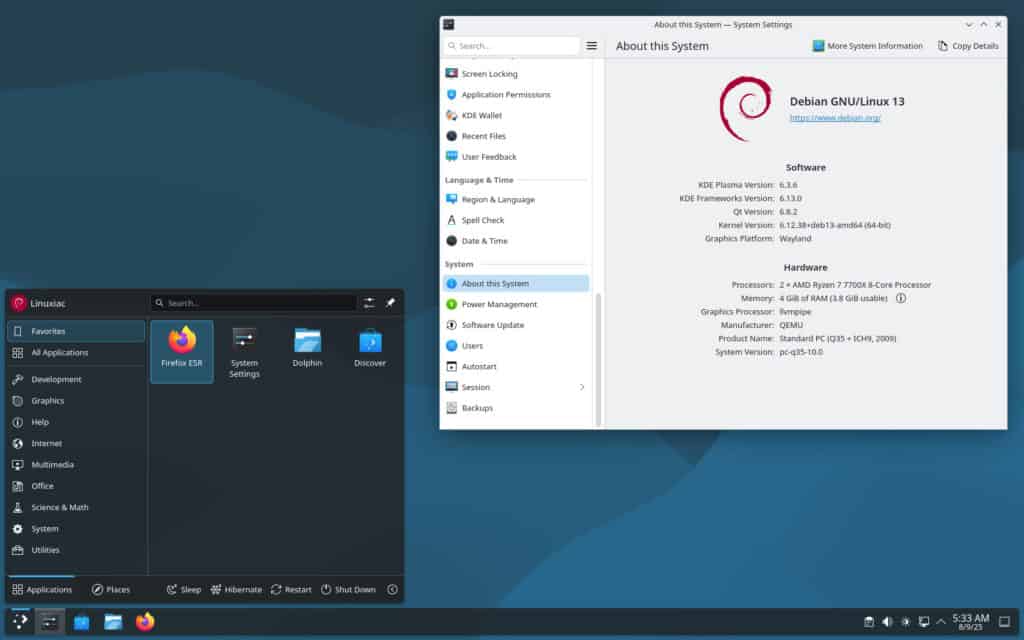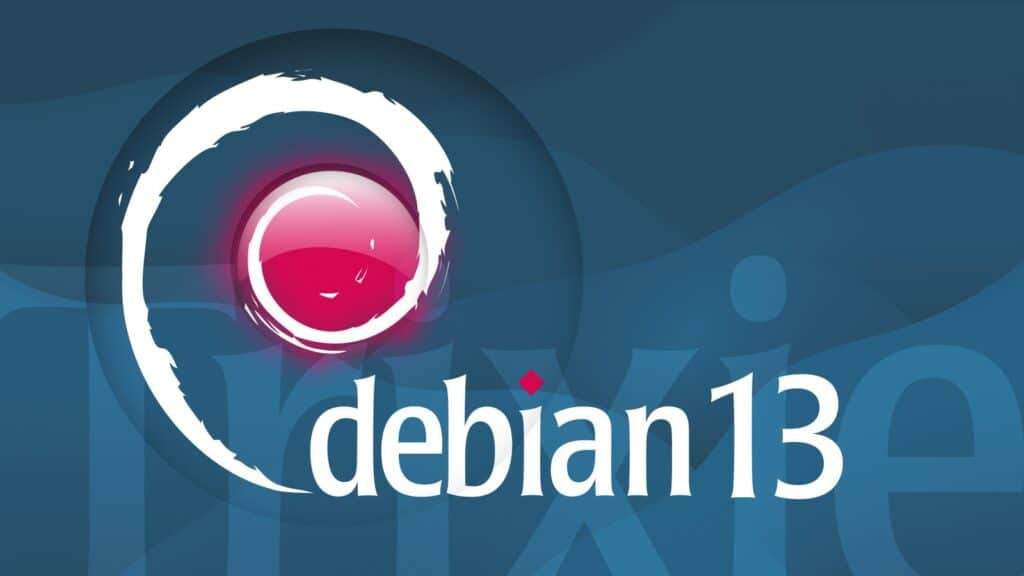Exactly 2 years, 1 month, and 29 days after the release of Debian 12 “Bookworm,” Debian 13 “Trixie” is now here, powered by Linux kernel 6.12 LTS, with an entirely refreshed package base, serious security enhancements, and a whole bunch of new features.
For the first time, Debian officially supports the 64-bit RISC-V (riscv64) architecture. This means that owners of compatible RISC-V hardware can now enjoy the same Debian experience as users on more established platforms, complete with the full breadth of packages and long-term support.
Of course, Trixie also continues to offer robust support for other architectures, including amd64, arm64, armel, armhf, ppc64el, and s390x. On 64-bit PCs, partial i386 userland support remains available — but with reduced scope, as i386 has been demoted to legacy status.
And now, here’s something sure to get home users who depend on Debian for their everyday computing pretty excited—desktop environments. As you would expect, everything has been updated. With Debian 13, you get KDE Plasma 6.3.6, GNOME 48, Cinnamon 6.4, LXQt 2.1, and Xfce 4.20.

Under the hood, package versions leap forward almost across the board: LibreOffice 25.2, GIMP 3.0.4, Inkscape 1.4, GCC 14.2, Python 3.13, PHP 8.4, OpenSSL 3.5, MariaDB 11.8, and PostgreSQL 17 are just a few examples from over 14,000 new packages compared to Debian 12 “Bookworm,” bringing the total count to more than 69,800.
For developers and sysadmins, there’s HTTP/3 support in curl, plus a handy new download tool, wcurl, which works like wget but runs on curl. Plus, Debian’s installer and live images now support HTTP Boot, letting users load ISOs directly over the network on systems with compatible UEFI or U-Boot firmware.
Moreover, when it comes to modernization in Debian 13, two points in particular are worth calling out. First, all architectures except i386 now use a 64-bit time_t, solving the Year 2038 problem for good. On some 32-bit architectures, software will need to be rebuilt to avoid silent data loss.
And second is about the reproducible builds. What I mean is that a new debian-repro-status package lets users check which of their installed packages build reproducibly, and a new rebuilderd package helps verify results.
Next stop – probably the most fundamental system component – the APT package manager. Trixie brings with it the long-awaited APT 3.0, replacing the APT 2.6 lineage from Bookworm. And believe me, this upgrade isn’t just a number bump—it brings real, tangible benefits:
- A refined, columnar, and color‑coded user interface, making interactions far more intuitive. Removals are shown in red, new installs or upgrades in green, and the layout is clean and easy to scan.
- Solver3, a smarter backtracking dependency resolver, delivers enhanced conflict management and fallbacks, reducing risk during complex updates.
- Under the hood, APT now embraces stronger cryptographic support, shifting from GnuTLS/GnuPG to OpenSSL and Sequoia, and replacing deprecated tools like
apt-keywith modern alternatives—streamlining both security and key management. - Progress is clearer too, with a Unicode-powered progress bar offering smooth, real-time feedback.
However, as with any major release, there are some caveats. Here are the most important ones:
- i386 no longer has its own installer or kernel, and is now intended solely for legacy code support on amd64 systems.
- MIPS architectures (mipsel and mips64el) have been dropped.
/tmpis now tmpfs by default, which speeds up temporary file operations but could lead to memory limits with large files.- OpenSSH drops DSA key support entirely, and no longer reads
~/.pam_environment. - Tools like
last,lastb, andlastloghave been replaced due to Year 2038 limitations. - MariaDB upgrades require a clean shutdown before moving to version 11.8.
- The libvirt and Samba packages have been reorganized, meaning administrators should double-check which components are installed after upgrading.
Lastly, with Debian 13, several blends — including Debian Junior, Debian Science, and Debian FreedomBox — can now be installed directly from within the Debian installer itself. This makes it much easier for users with specialized needs to get a fully configured system right from the start, without having to hunt for and install the necessary packages manually.

For more information, see the announcement or refer to the release notes for detailed information about all changes in Debian 13. You can download Trixie’s installation ISO from the project website’s download section.
Debian 13 “Trixie” will receive a five‑year support lifecycle—comprising approximately three years of full support, until August 2028, with updates and security fixes, followed by a two-year LTS phase until August 2030.
If you’re running Debian 12 and want to upgrade but are still trying to figure out how to do it, don’t worry. We’ve got you covered. You can easily do it by following our comprehensive “How to Upgrade to Debian 13 (Trixie) from 12 (Bookworm)” step-by-step guide for hassle-free execution.

Sad that they have dropped support for MIPS seams like debian Is becoming less and less a universal operating system but at least we got RISC-V support
I have had lots of issues trying to install debian 13 It took 4 different graphics cards all of which worked with debian 12 to even be able to use the graphical installer
Warning for NVidia user’s : DO NOT USE Debian 13 (driver and kernel are broken)
https://duckduckgo.com/?q=kernel+6.12+nvidia+broken&df=y&t=vivaldi&ia=web
Plasma 6 still has too many bugs. I’m staying on Debian 12 (KDE 5.27) until June 2028. No rush.
no mate no download
Debian 13 “Trixie” supports MATE desktop:
https://packages.debian.org/trixie/mate-desktop
apt install mate-desktop
There are now laptops with a built-in fingerprint sensor on the touchpad. Will they be supported on Linux?
no idea if debian has it but ubuntu gives fingerprint setup directions but i have never tried this.
https://help.ubuntu.com/stable/ubuntu-help/session-fingerprint.html.en
I’m currently running Mint 22.1. I’ve been thinking of switching to LMDE. My question is, what’s the difference between using LMDE and Debian, if Deb 13 has the same DR’S as Mint?
Hi,
The difference between LMDE and plain Debian 13 mainly comes down to Mint’s customizations and user experience — not so much the base packages, since LMDE 7 (when it comes) will indeed share the same Trixie package base. Both are great options. However, in terms of user-friendliness, LMDE is the way to go for a few reasons – you get Mint’s Cinnamon desktop preconfigured, plus Mint tools and Mint-specific defaults. In short, LMDE is essentially “Debian Stable + Mint experience”.
They (Debian developers) made the same mistake when Debian (bookworm) 12 came out as a final release. The ISO image filesize is greater than 700 MegaBytes, so it *_can not be written_* on a 700 MegaBytes CD:
debian-13.0.0-amd64-netinst.iso 2025-08-09 15:29 754M
found at
cdimage.debian.org/debian-cd/13.0.0/amd64/iso-cd/
[Solution to work around this problem]
go to
https://deb.debian.org/debian/dists/trixie/main/installer-amd64/current/images/netboot/
and download the 64MegaBytes mini.iso
Bookworm was the first shot at modernizing Debian, and Trixie is the continuation. Just like how 32 bit support is going away, physical cd install is probably on its way out too. Yes, they should probably rename the ‘CD’ install, but if you’re still installing on physical discs, just like 32 bit support you should probably have been looking at other install methods a decade ago.
Exactly, how annoying. They should do what FreeBSD does and have a USB stick image with tools to netinstall (so what is already the 754MB “CD” image), a real CD image that’s under 700MB and is more minimal, and a DVD image that’s complete without the need for an internet connection (under 4.7GB).
Who uses CDs and DVDs to write .iso medias to in 2025??? Its the USB age now 🤣🤣🤣🤣
I still have motherboards (or BIOSes) that have trouble booting from USB. So I still have DVDs around. CDs however are no more of great use. And a trademark of Linux is to support older hardware.
Thanks for the good news! I was looking forward to this release.
I had no idea Debian Blends existed though, and I was wondering if they did, like Ubuntu and Fedora do.